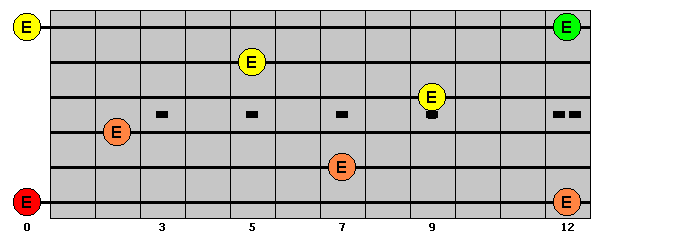The Octave on the Guitar

Click on any note to hear
Octaves of E on Guitar and Musical Staff
In this diagram all the E notes in the first 12 frets are mapped and highlighted. The lowest E in pitch is red, the next higher E notes are orange, followed by the yellow and green in ascending order. Note the lines of equal pitch connecting notes of the same pitch and follow the lines up to the musical staff. Each line is one octave apart. Jumping from a red E to any orange E is an interval of one octave. Going from a red E to a yellow E is 2 octaves. This arrangement of notes holds true for any note on the guitar. For example, if I highlighted all the G notes, the map would look exactly the same but with every colored note 3 frets to the right.
Remember an octave refers to a doubling in pitch. Play each note along the bottom E string from the red E to the orange E. Notice there are 12 frets in one octave. Going to any orange E from the red E is equal to moving 12 frets in a straight line (horizontal). Moving left or right one fret is an interval of a half-step. Moving left or right two frets is an interval of a whole step. You can refer to them as semitones and whole tones also. The Sharp moves a note up one semitone (half-step), while a Flat moves a note down a semitone. See more about intervals here.
A root note is the first note of a scale or chord. In this book, the lowest root note (in pitch) will be colored Red, Orange, Yellow, Green and Blue in ascending order.
Octave Mapper
Below you can study each notes octaves, one at a time. Learning these root positions will help you greatly in all guitar studies!
